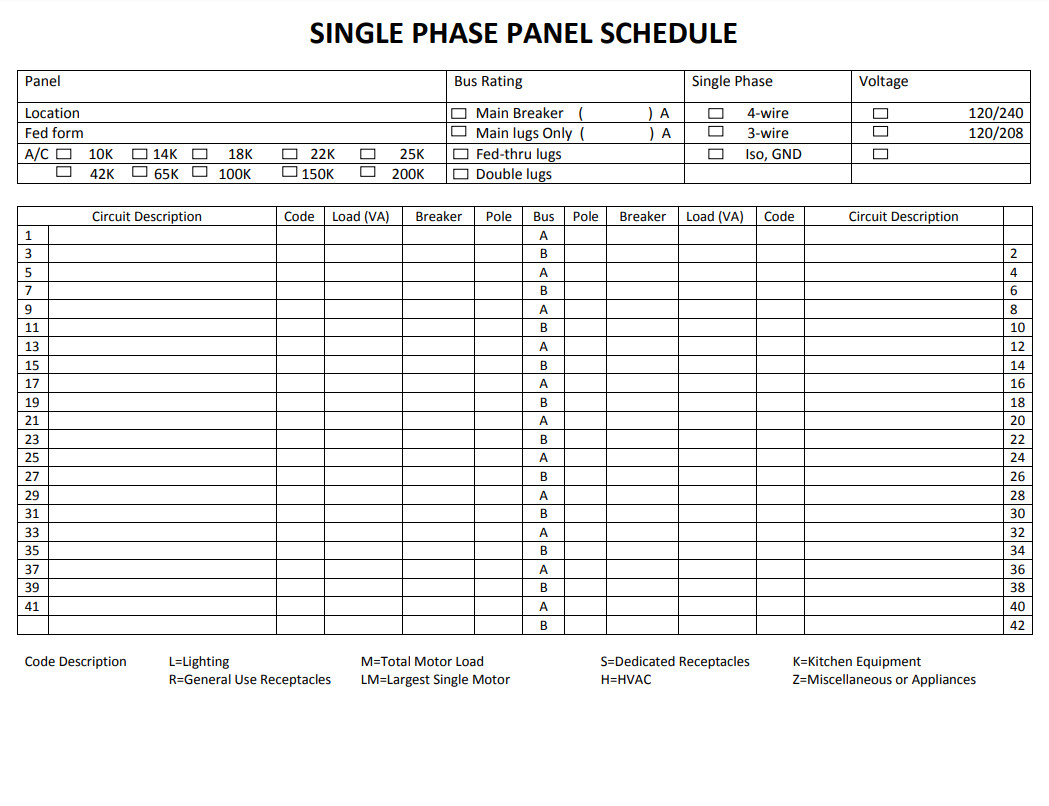
When efficiently managing the distribution of electricity within a building, having a well-organized panel schedule is essential for electrical engineers and professionals. A printable panel schedule template is a valuable tool for documenting crucial information related to the electrical panel box.
By utilizing these templates, individuals can easily track and monitor the circuit details, breaker sizes, loads, wire sizes, and other pertinent data necessary for maintaining an effective electrical system.
In this article, we will delve into the significance of printable panel schedule templates, explore their benefits, and provide insights on creating and utilizing them effectively.
What is a Panel Schedule?
A panel schedule is a crucial document used by electrical engineers to monitor electricity distribution within a building. It typically includes details such as total voltage, number of wires with names and types, number of circuit breakers, and individual loads on each circuit breaker. This organized information helps in efficiently managing the electrical system in commercial and industrial settings.
The purpose of an Electrical Panel Schedule is crucial for efficiently managing the distribution of electricity in various settings. Here are the key reasons why maintaining an Electrical Panel Schedule is essential:
- Safely Distribute Electricity: The panel schedule helps to safely and reliably distribute electricity to individual circuit breakers.
- Protect Electrical System: It aids in protecting the electrical system from any potential overload issues.
- Track Power Supply: The schedule allows for tracking the power supply and estimating the load at different stages.
- Accurate Voltage Provision: Particularly useful in commercial and industrial areas where accurate voltage provision is necessary.
- Manage Electricity Distribution: Helps in managing electricity distribution, especially during high consumption periods like working hours.
- Facilitate Decision Making: Enables better decision-making regarding electricity loads in the future.
- Reduce Electrical Failure Risk: By maintaining a schedule, the risk of electrical failure is significantly reduced.






Key Component of a Panel Schedule
The key component of a panel schedule template is crucial for effectively monitoring the distribution of electricity in commercial and industrial settings. To ensure efficient management of the electrical system, the panel schedule template must include essential information such as:
- Total voltage/main power: This indicates the overall voltage capacity or main power source of the electrical panel.
- Number of wires with names and types: It is important to list the number of wires along with their specific names and types for easy identification and maintenance.
- Number of circuit breakers: The template should specify the total number of circuit breakers installed in the panel for circuit protection.
- Individual load on each circuit breaker: Detailing the load capacity of each circuit breaker helps balance the electrical distribution and prevent overloads.
By incorporating these factors into the panel schedule template, electrical engineers can effectively organize and manage the electricity distribution system within a building.






How to Create a Panel Schedule
To create a Panel Schedule, follow these detailed steps:
- Open Excel and Start a New Blank Workbook: Begin by opening Excel and creating a new blank workbook to work on.
- Create the Document Header: Go to the Insert tab, click on the “Text” group arrow, and select the header and footer option. Write the title of the document as “Panel schedule.” Below the title, add “Panel Name” and “Panel Location.”
- Add the First Column: In cell A1, write the first column header as “Circuit.” This will be the starting point for listing the circuits.
- Add the Second Column: Move to cell B1 and label it as “Size of the circuit breaker.” This column will contain information about the size of each circuit breaker.
- Include Additional Columns: Continue adding columns for “Load” (voltage) and “Wire Size” to provide more detailed information about each circuit.
- Customize Columns: Add more columns as needed to record specific information about the circuits in the panel schedule.
- Save the Document: Once you have added all the necessary columns and information, go to the “File” tab, click on “Save As,” and give your file a name. Click “OK” to save the document.






Final Thoughts
Utilizing a printable panel schedule template is an efficient way to organize and monitor the distribution of electricity within a building. Whether you choose to download a pre-designed template or create your own in Excel following the simple steps provided, having a well-structured panel schedule is essential for electrical engineers and professionals.
By accurately recording information such as circuit details, breaker sizes, loads, and wire sizes, you can ensure the smooth functioning of electrical systems and maintenance tasks. With the availability of various formats like Word, PDF, and Excel, creating and maintaining a panel schedule has never been easier.
Stay organized, stay informed, and stay on top of your electrical panel management with the help of these templates.